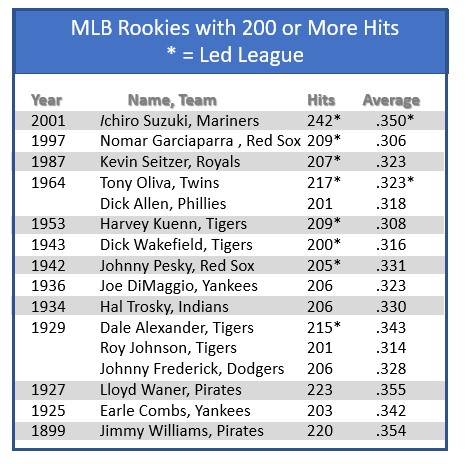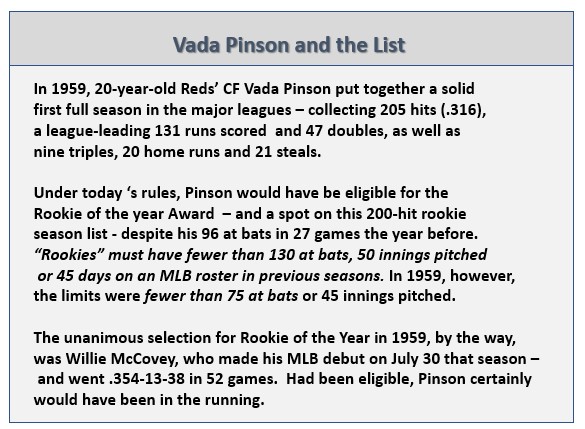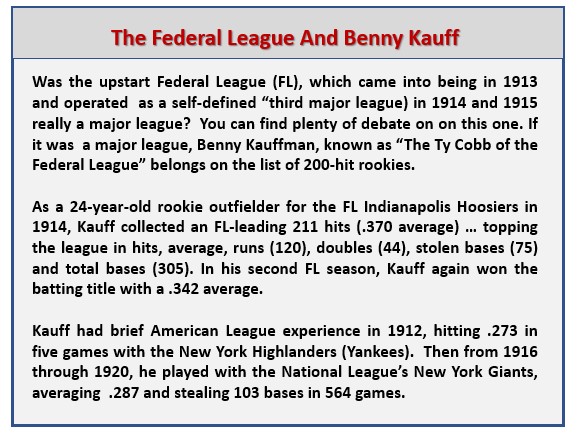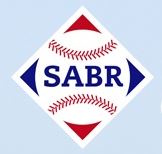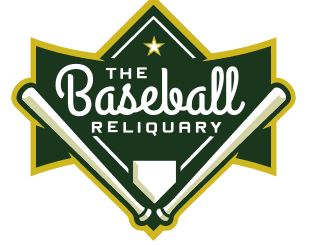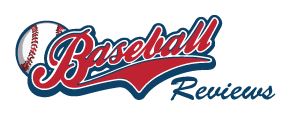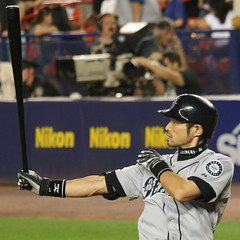
Photo by OlympianX 
Baseball Roundtable continues to reflect on past seasons, while looking forward to the return of “new” baseball. In this post, I’m taking a look at players who delivered 200 or more base hits in their rookie season. By the way, that’s not a very large group. Only 16 MLB rookies have collected 200 or safeties.
Now, to perhaps entice readers to make their way through this post, here are a handful of questions about this sweet sixteen. And, to help you on your way, here is a hint – the initials of the sixteen players sin reverse chronological order. IS; NG; KS; TO; D (or R) A; JP; JD; HT; DA; RJ; JF; LW; EC; JW.
Now the questions:
_______________________________________________________________________
- Which one of the six 200-hit rookies who achieved the feat after the Rookie of the Year Award was established in 1947 did not win the ROY?
- Which three of the 16 players with 200-hit rookie seasons are in the Hall of Fame?
- Only one of the 200-hit rookies whose rookie season occurred after the first MLB all Star Game never made an MLB All Star team. Name him. Extra hint here: HT
- Seven of the 16 rookies with 200-hit seasons never reached 200 safeties in another campaign. How many can you name/guess?
- Which four 200-hit rookies led their league in triples in their initial 200-safety season? Hint: One from the 1990s; one from the 1960s; one from the 1930s; and one from the 1890s.
________________________________________________________________________
Before we take an in-depth look at these 200-hit rookies, here are the answers to the questions.
- Kevin Seitzer
- Joe DiMaggio, Lloyd Waner, Earle Combs
- Hal Trosky
- Nomar Garciaparra, Kevin Seitzer, Dick Allen, Dick Wakefield, Dale Alexander, Roy Johnson, Jimmy Williams
- Nomar Garciaparra, Dick Allen, Joe DiMaggio, Jimmy Williams
___________________________________________________________
Now a closer look at MLB’s 200-hit rookie seasons.
Ichiro Suzuki, Mariners, 2001
Ichiro Suzuki holds the record for the most hits by any MLB rookie, racking up 242 safeties for the Mariners in 2001. That season, he led the American League in hits, batting average (.350) and stolen bases (56) – earning Rookie of the Year and Most Valuable Player honors. A free-swinger, he drew only 30 walks (and ten of those were intentional) in a league-topping 738 plate appearances. There are those who would support an asterisk by this rookie-hits record (I’m not one of them), since Suzuki came to MLB (as a 27-year-old rookie) after nine seasons with Japanese Baseball’s Orix Blue Wave – where he put up a .353 batting average (1,278 hits) in 951 games.
Suzuki played 19 MLB seasons (2001-2019 … Mariners, Yankees, Marlins), collecting 3,089 hits (.311 average), leading the league in hits seven times and setting the all-time, single-season hits record of 262 in 2004. He was a ten-time All Star, a two-time batting champion and ten-time Gold Glover in the outfield. Over his MLB career, he scored 1,420 runs (topping 100 in eight seasons), hit 117 home runs, drove in 780 and stole 509 bases (topping 30 steals ten times).
Keep the Line Moving
After collecting 242 hits in his rookie campaign, Ichiro Suzuki garnered 200 or more safeties in each the next nine seasons. His ten consecutive 200-hit seasons are an MLB record. and tie him with Pete Rose for the most 200-hit seasons in a career. Over his first ten MLB seasons, Suzuki’s average season was .331, with 224 hits, 105 runs scored, 56 RBI, nine home runs and 38 steals.
Nomar Garciaparra, Red Sox, 1997
Nomar Garciaparra kept his rookie status into 1997, after hitting .241-4-16 in 24 games in 1996. In his 1997 Rookie of the Year season, the Red Sox ‘shortstop hit .306 (a league-leading 209 hits), with 30 home runs, 98 RBI, 122 runs scored and 22 stolen bases. He also led the American League in triples with 11.
Home Cookin’
Nomar Garciaparra is one of only 13 players with two Grand Slams in a single game – and the only one to do it in his home park.
In a 14-season MLB career (1996-2009 … Red Sox, Cubs, Dodgers, A’s), Garciaparra (while never again reaching 200 hits), was a six-time All Star and two-time batting champion (.357 in 1999 and .372 in 2000 – both with the Red Sox). Garciaparra also led the league in doubles once (topping 50 doubles in two season), scored 100+ ruins six times, topped 100 RBI four times and hit 20 or more round trippers in seven seasons. His career average was .313, with 229 home runs, 936 RBI, 927 runs scored and 95 stolen bases. He also hit .321-7-24 in 32 post-season contests.
Kevin Seitzer, Royals, 1987
Kevin Seitzer hit .323 in a September 1986 call up (28 games). (His trip to the Royals came after a .318-13-75 season at Triple A and Double A.) In 1987, still retaining his rookie status, Seitzer proved 1986 was no fluke, hitting an identical .323 (207 hits) over 161 games. He also had 11 home runs, 83 RBI, 105 runs scored and 12 stolen bases. In most seasons, that would be good enough for Rookie of the Year honors. In 1987, however, Seitzer finished a distant second in the voting, as all the first-place AL votes went to Mark McGwire, who put up a .289-49-118 line.
Big Day for a Rookie
On August 2, 1987, as the Royals topped the Red Sox 13-5, in Kansas City, Kevin Seitzer has a six-for-six day, with two home runs, four runs scored and seven RBI. Seitzer is one of only two Royals with a six-for-six day at the plate. (The other is Bob Oliver.)
Seitzer went on to a 12-season MLB career (1986-97 … Royals, Brewers, A’s, Indians). He collected 1,557 hits (never again reaching 200 in a season) for a .295 average, with 74 home runs, 613 RBI, 739 runs scored and 30 steals. He was twice an All Star (1987 and 1995). His rookie campaign saw him record his career highs in games, plate appearances, at bats, runs, hits, triples, home runs and RBI. Over his career, he started 1,014 games at 3B, 208 at 2B, 119 at DH, nine in the OF and one at SS.
Tony Oliva, Twins, 1964
Twins outfielder Tony Oliva enjoyed two brief call ups (1962-63) before his first full MLB season (in 1964, when he still retained rookie status, having played in just 16 games – hitting .438 – in two previous stints with the Twins). In that 1964 campaign, Oliva led the American League in hints (217), batting average (.323), runs scored (109), doubles (43) and total bases (374), while also launching 32 home runs, driving in 94 runs and swiping 32 bases.
T(ony) for Two
Tony Oliva is the only player to win a batting title in his rookie and sophomore MLB seasons – .323 in 1964 and .321 in 1965.
Oliva went on to lead the AL in hits in four of the next six seasons (reaching 200+ safeties once more), as well as to earn a third batting title (1971). He played 15 MLB seasons (1962-76), all for the Twins and was an eight-time All Star and one-time Gold Glover. Oliva hit .300 or better in six of the eleven seasons when he played at least 100 games. The eight-time All Star also led the league in doubles four times. He retired from the playing fields with a .304 average (1,917 hits), 220 home runs, 947 RBI and 870 runs scored. Oliva hit .314, with three home runs, in 13 post-season games.
Dick Allen, Phillies, 1964
In 1963, Dick Allen played ten games for the Phillies after a September call up – primarily as a LF (one appearance at 3B). Then, in his 1964, Rookie of the Year season, he became the Phillies’ full-time third baseman and quickly showed his power. That season, Allen hit .318, with 29 home runs and 91 RBI. He led the NL in runs scored (125), total bases (352) and triples (13). He went on to a become a seven-time All Star and the 1972 American League MVP – when he hit .308-37-133 for the White Sox, leading the league in home runs and RBI. Allen played 15 MLB seasons (1963-77 … Phillies, Cardinals, Dodgers, White Sox, A’s). He put up a .292 career average (hitting .300 or better in seven seasons); 351 home runs (leading his league twice and topping 30 long balls in six campaigns); and driving in 1,119 runs (leading the league once). Known more for his power than his speed, Allen had 79 career triples, and had ten or more three-baggers in four seasons. He also swiped 133 bases, with a high of 20 steals (in 25 attempts) in 1967. Over his career, Allen started 795 games at 1B; 646 at 3B; and 249 in the outfield. Allen had two brothers Hank and Ron, who also played in the major leagues.
Music to My Ears
Dick Allen was also an accomplished doo-wop singer, performing professionally with his band “Rich Allen and the Ebonistics. Click below for a sample.
Harvey Kuenn, Tigers, 1953
After a brief call up in 1957 (19 September games), Harvey Kuenn settled in as the Tigers’ full-time shortstop in 1958 – earning a spot on the AL All Star team, as well as Rookie of the Year honors. That season, Kuenn led the AL in hits (209), while batting .308. He scored 94 runs, drove in 48, hit two homers and stole six bags. Kuenn went on to make the AL All Star squad in every season from 1953 through 1960, batting over .300 in all but one of those campaigns and leading the league with a .353 average in 1959. Over his career, Kuenn led his league in hits four times (with 200+ hits twice) and doubles three times.
Even Exchange. I’ll give You One Harvey Kuenn for …
After leading the AL with a .353 batting average in 1959, Kuenn was traded (just before the start of the 1960 season) to the Cleveland Indians for 1959 home run champion Rocky Colavito (42 home runs).
Kuenn played 15 MLB seasons (1952-66 … Tigers, Indians, Giants, Cubs, Phillies). He put up a .303 average (2,092 hits), with 87 home runs, 671 RBI, 950 runs scored. Starting primarily as a SS, he eventually shifted to the outfield. During his career, he started 758 games in the OF, 742 at SS, 130 at 3B and 16 at 1B. After retiring as a player, Kuenn, tried his hand at managing and led the 1982 Brewers to the American League Championship.
Dick Wakefield, Tigers, 1943
Dick Wakefield’s Rookie of the Year season was a bright one – as the Tigers’ outfielder (just 22-years-old) led the American League in games (155), hits (200) and doubles (38), while hitting .316, with seven home runs, 79 RBI and 91 runs scored. It seems the highly touted rookie was on his way to a great career.
The Old College Try
Dick Wakefield was a star in his only college season – 1941, University of Michigan – hitting .368, with nine home runs in 26 games. That summer, he was invited for tryout with a number of MLB teams and eventually signed with the Tigers for a reported $52,000 and a new automobile (makes sense for Detroit). How significant was that bonus? At that time, Hank Greenberg was MLB’s highest paid player at $55,000 – and he was a two-time MVP.
Wakefield’s early success did not come as a surprise. After a short, but stellar, college career, he spent most of the 1941 seasons at B-Level Winston Salem, but got a taste of the major leagues, appearing in seven games as a 20-year-old. In 1942, he was assigned to the High-A Beaumont Exporters, where he hit .345 in 149 games and earned Texas League Most Valuable player honors.
The big (6’4”, 210-pound) outfielder came back strong in 1944, hitting .355-12-53 in 78 games in a season interrupted by military service. He missed the entire 1945 season and, when he returned to the Tigers in 1946, he seemed to have lost a bit of his edge – a situation amplified by a pair of injuries (broken wrist/HBP and broken left forearm/collision with outfield wall). He averaged just .268 for the remainder of his MLB career.
Wakefield played all or part of nine seasons in the majors (1941, 1943-44, 1946-50, 1952 … Tigers, Yankees, Giants). He finished with a .293 career average, 56 home runs, 315 RBI and 334 runs scored.
Johnny Pesky, Red Sox, 1942
Twenty-three-year old Red Sox’ shortstop Johnny Pesky had a strong rookie campaign (1942), leading the American League with 205 hits and putting up a .331 average, with two home runs, 51 RBI, 105 runs scored and 12 steals.
.325 Can be a Lucky Number
Johnny Pesky played two minor-league seasons before joining the Red Sox in 1940, he played 136 games with the Class-B Rocky Mountain Red Sox and hit .325. Promoted to the Double-A Louisville Colonels in 1941, he played 146 games and again hit .325.
Pesky’s major league career was interrupted by three years of military service (1943-45), but when he returned, he picked up right where he left off. – leading the league in hits in 1946 (208 hits, .335 average) and 1947 (207 hits, .324 average).
Pesky played ten MLB seasons (1942, 1946-54 … Red Sox, Tigers, Senators). His career average was .307, with 17 home runs, 404 RBI and 867 runs scored. He scored 100+ runs in six seasons and hit for a .300+ average in six campaigns. He was an All Star in 1946. Over his career, Pesky started 579 games at SS, 455 at 3B and 104 at 2B.
Rounding the Bases, Again and Again and Again
Johnny Pesky was the first American Leaguer to score six runs in a nine-inning game (still the AL record, since tied by Spike Owen and Joe Randa). The only MLB player to reach seven runs scored in nine innings is Guy Hecker – for the 1886 American Association Louisville Colonels.
Joe DiMaggio, Yankees, 1936
Yankee outfielder Joe DiMaggio made his MLB debut as a 21-year-old on May 3, 1936 – and he had a pretty good day. DiMaggio went three-for-six, with two singles and a triple, scoring three runs and driving in one – as the Yankees topped the Browns 14-5 in New York. Joltin’ Joe went on to play 138 games, put up a .323 average, with 206 hits, 29 home runs, 125 RBI and 132 runs scored. He also led the American League with 15 three-baggers.
Despite missing three seasons due to military service (1943-45), DiMaggio played 13 MLB seasons (1936-42, 1946-52), all with the Yankees. He was an All Star in every season, a three-time Most Valuable Player, a two-time batting champ (ten times hitting .300+), a two-time RBI leader (nine seasons of 100+), a two-time home run leader (seven seasons of 30 or more) and once lead the AL in runs scored (eight seasons of 100+). He retired with a .325-361, 1,537 stat line.
56? Been There, Done That
Joe DiMaggio 56-hitting streak in 1941 remains the longest in MLB history. DiMaggio, however, had a longer steak in the minors – 61 games, as an 18-year-old rookie, for the Pacific Coast League San Francisco Seals in 1933. The only longer streak in professional baseball history belong to Joe Wilhoit, who hit in 69 consecutive games for the Wichita Jobbers of the Western League in 1919.
Hal Trosky, Indians, 1934
Hal Trosky got an 11-game taste of the major leagues, as a 20-year-old, late in the 1933 season. Then in 1934 – rookie-status still intact – Trosky played in all 154 games at first base for the Indians. Trosky collected 206 hits, launched 35 home runs and drove in 142 in that rookie campaign. He went on to play in 11 MLB seasons (1933-41, 1944, 1946 …. Indians, White Sox). From 1933 through 1938, Trosky averaged .314, hit 155 home runs and drove in 663. In 1938, migraines began to take a toll on his skills and ability to stay in the game. He missed the entire 1942 and 1943 seasons.
Tough Competition
Hal Trosky may be one of the best players to never make an All Star team. Then again, his competition at first base included Lou Gehrig, Jimmie Foxx and Hank Greenberg.
Over his 11 MLB seasons, Trosky hit .302 (four times topping .300), with 228 home runs (three times hitting 30+) and 1,012 RBI (topping 100 in six seasons). He led the American league with 162 RBI and 405 total bases in 1936, when he went .343-42-162.
Dale Alexander, Tigers, 1929
Dale Alexander’s story is one of a potential Hall of Fame career derailed by a freak injury. Alexander made it to the major leagues, with the Tigers, as a 26-year-old rookie in 1929. This came after six minor-league seasons in which he hit ,333 in 783 games.
As a rookie with the Indians, Alexander played in all 155 games, hitting .343 and collecting a league-leading 215 hits – plus 25 home runs, 137 RBI and 110 runs scored. The following season, he again played in every Indian’s contest (154 games) – hitting .326-20-135. Over the next two seasons, he continued his torrid batsmanship, hitting .325 in 1931 and winning the American League batting title at .367 in 1932 (a season he split between the Tigers and Red Sox).
Then misfortune struck. On Memorial Day in 1933, Alexander suffered a knee injury that was addressed with a new, electric, deep-heating treatment. Alexander was left on the machine for too long – suffering third-degree burns and a subsequent infection (at one point amputation was even considered). While he did come back to play that season, his speed and mobility were limited by the aftermath of the injury and treatment. He finished the season with a .281 average in 94 games – and 1933 marked his last season in the major leagues. Dale Alexander’s MLB career was finished at five seasons (1929-33 … Tigers, Red Sox. He played in 662 games and put up a .331 average, with 61 home runs and 459 RBI.
Keep on Keeping ON
Dale Alexander did not leave baseball after his 1933 health issues derailed his MLB career. He played nine more season in the minor leagues – hitting .336 over 976 games. He notably served as a player-manager in four of those seasons. He later continued to be involved as both a minor-league manager and scout (for the Giants and Braves).
Roy Johnson, Tigers, 1929
Rookie Roy Johnson patrolled the outfield for the Tigers in 1929, collecting 201 hits (.314 average), ten home runs, 69 RBI, 128 runs scored and 20 stolen bases. He also led the AL with 45 doubles. It was Johnson’s only 200-hit campaign.
Chasing ’em Down
In 1931, Roy Johnson led American League right fielders in putouts (309), assists (24) and double plays (8). He was also third in errors with 15.
Johnson played ten MLB seasons (1929-38 …. Tigers, Red Sox, Yankees, Bees). He hit .296 (1,292 hits), topping .300 four times. He finished with 58 home runs, 555 RBI, 716 runs scored (with 100+ runs in three seasons) and 135 steals (reaching 20 in two seasons). He also led The AL in triples, with 19 for the Tigers in 1931.
Johnny Frederick, Dodgers, 1929
Johnny Frederick made his debut as an outfielder with the Brooklyn Dodgers in April of 1929. He played in 148 games in his rookie season, collecting 206 hits (.328 average), with 24 home runs, 75 RBI, 127 runs scored and a league-leading 52 doubles. He followed that up with a 1930 campaign that again saw him rap 206 hits, this time with a .334 average, 17 homers, 76 RBI and 120 runs scored.
Good in a Pinch
In 1932, Johnny Frederick went 10-for 32 as a pinch hitter (.313), and hit a then-record six pinch-hit home runs – a PH-homer record that stood until Dave Hansen hit seven pinch-hit long balls in 2000.
Frederick was a solid hitting outfielder over six MLB seasons (1929-34), all with the Dodgers. He had a .308 career MLB average with season marks of .328, .334, .270, .299, .308, and .296. He drove in 377 runs, scored 498 and stole 23 bases. In December of 1934, he was traded by the Dodgers to Sacramento of the Pacific Coast League for Frenchy Bordagary. Frederick played six more season in the PCL, averaging .329 over 978 games, but never again appeared in an MLB box score.
Lloyd Waner, Pirates, 1927
Hall of Fame outfielder Lloyd Waner collected 223 hits (.355 average) in his 1927 rookie seasons (age 21). He had just two home runs and 27 RBI (in fact, he had just 25 extra base hits), but the Pirate led the NL in runs scored with 133. Waner stroked 200+ hits in four of his first five season, only missing the magic number in 1930, when he plated in only 68 games.
Brotherly Love
Lloyd Waner and his brother Paul – known as “Little Poison” and “Big Poison,” respectively – both hit their way into the MLB Hall of Fame. Together they collected the most hits by any MLB brothers (5,611 … 3,152 for Paul and 2,459 for Lloyd).
Lloyd Waner played 18 MLB seasons (1922-42, 1944-45 … Pirates, Braves, Reds, Phillies, Dodgers). He put up a .316 career average (2,59 hits), hit 27 home runs, drove in 598 and scored 1,201, The one-time All Star led his league in hits once (topping 200 four times); runs once (topping 100 three times); triples once (20 in 1929). Of his 2,459 hits only 426 went for extra bases.
Earle Combs, Yankees, 1925
Yankee CF Earle Combs got in 24 games for the Bronx Bombers in 1924 – going 10-for-35 (.400). His inaugural MLB season was cut short by a broken ankle suffered in mid-June. In 1925, with his rookie status still intact, he built upon that “cup of coffee,” hitting .342-3-62 and notching 203 hits. He also scored 113 runs and stole 12 bags. The Hall of Famer went to have a 21-season MLB career (1924-35), all with the Yankees; averaging .325 (,300 or better in all but two seasons), with 58 home runs, 633 RBI and 1,186 runs scored. He had three 200+ hit seasons and eight seasons in which scored 100+ runs. He led the AL in hits once and triples three times, hitting 20+ three-baggers in each of those seasons.
Bad Timing, Earle
Earle Comb’s best season was 1927, when he hit .356, scored 137 runs and led the AL with 231 hits and 23 triples. He didn’t get the attention he deserved for those numbers; since teammate Babe Ruth went .356-60-165 that year.
Jimmy Williams, Pirates, 1899
Jimmy Williams made his major league debut in 1889 as a third baseman for the Pittsburgh Pirates. The 22-year-old, who would spend most of his career as a second basemen, hit .354-9-116, with 126 runs scored and 26 steals that season. (It would be the only times he reached 160 hits in his 11-season MLB career). He led the NL with 27 triples that season. In his rookie season, William set his career highs in games (153); hits (220); average (.354); RBI (116); runs (126); home runs (9); triples (27); and total bases (329).
Three Standing Tall
Jimmy Williams’s 27 triples for the Pittsburgh Pirate in 1899 remains the rookie record for three-baggers.
Jimmy Williams played 11 MLB seasons (1899-1909 … Pirates, Orioles, Highlanders, Browns). His career average was .275, although he hit .300 or better in three of his first four seasons. He scored 100+ runs in two seasons, led the league in triples three times, hit 49 home runs and drove in 796, while scoring 780 times and stealing 151 bases.
Primary Resource: Baseball-Reference.com; Stathead.com; Dick Wakefield, SABR bio, by Warren Corbett; Dale Alexander, SABR Bio, by Bill Nowlin.
 Baseball Roundtable is on the Feedspot list of the Top 100 Baseball Blogs. To see the full list, click here.
Baseball Roundtable is on the Feedspot list of the Top 100 Baseball Blogs. To see the full list, click here.
I tweet baseball @DavidBBRT
Follow/Like Baseball Roundtable’s Facebook Page here. More baseball commentary; blog post notifications; PRIZES.
Member: Society for American Baseball Research (SABR); The Baseball Reliquary; The Negro Leagues Baseball Museum.
